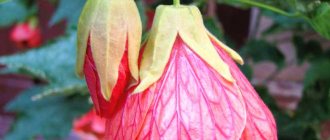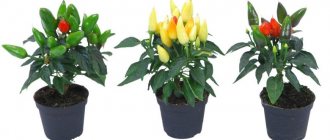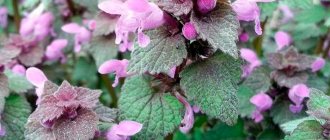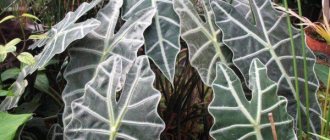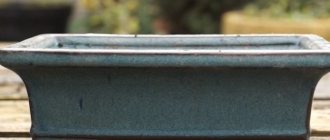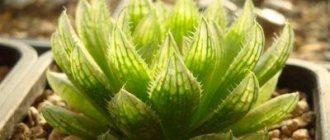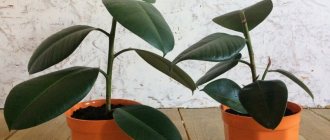Recently, there has been a fashion for using tropical plants in the interior, exterior, and clothing. I would like to introduce you to one of the brightest representatives of the tropics and subtropics - from Lat. Abutilon. It is also known as “Indoor maple” - so it is called for its leaves, which in their shape resemble maple leaves. And in India it is called “rope rope”, since its fibers make good rope rope and burlap.
1.Description 2.Home care 3.Diseases and pests 4.Planting and replanting 5.Pruning 6.Growing from seeds 7.Cuttings 8.Problems during cultivation 9.VarietiesPhoto: Abutilon is a beautiful tropical plant
Description of abutilone
Abutilon (rope plant) is an unpretentious plant. There are about 100 of its species. In nature it grows as a densely branching, rather large and voluminous shrub. The shape of the flowers resembles a large bell. Depending on the species, they can grow one or several flowers in a bunch.
Flowering lasts from April to November. Loves bright sunlight, but also grows quite well in some shade. Doesn't like drafts or cold air coming in from the window in the winter.
The optimal temperature for growing during the growing season is + 25 degrees. In winter, you need a lower temperature from + 12 to + 17 degrees and a fairly long daylight hours. It is best to place it on a south or west window, or provide additional illumination with a phytolamp. If the room temperature is less than +12 degrees, the plant will lose its leaves.
Photo: There are about 100 species of ropetail
What is a plant?
Abutilon is a large genus of the Malvaceae family. It includes both evergreen perennials and herbaceous annuals. Many of its species are grown as houseplants. This flower is a close relative of the hibiscus, and is often popularly called Indian mallow for its visual similarity to the popular plant.
Features that attract indoor plant lovers:
- The original shape of the leaves was the reason for one of the names of the plants - indoor maple;
- Long-term flowering - with indoor care, the bush can bloom from April to November;
- Fast growth, unpretentiousness and easy care.
Abutilone not only has beautiful leaves, but also unusual flowers. They are lowered down and resemble Chinese lanterns. The buds do not bloom for long, but new ones quickly grow to replace the withered and fallen ones.
In warm countries, abutilone is of industrial importance. Ropes, ropes, burlap, and wickerwork are made from its shoots.
Caring for abutilone at home
We also reduce spraying in winter, but do not stop. Since it is a tropical resident, it likes frequent and deep watering, as well as misting and showering, from late March to October.
- It will be ideal for the plant if you take it outside during the warm season. Choose a place where there is no strong wind or heavy rainfall (best near a wall or on the porch). If the location is chosen incorrectly, the plant may lose all its flowers, leaves, or even die.
- In winter, we reduce watering and water only after the top layer of the substrate has dried by 1 quarter.
- The flower loves high humidity, so it is best to place it near open water, if there is any in the winter garden or in the house.
- In winter, we place a container of water on the windowsill or place the pot in a tray with expanded clay, into which we periodically add water.
- During the flowering period, to care for indoor abutilon, we feed it 2 times a month with universal flower fertilizers.
- The dormant period is not pronounced, but an attentive gardener will notice from November to March that the plant slows down its growth and stops blooming.
Photo: Abutilone flowers resemble bells
How to grow a gorgeous abutilon bush: a reminder
I prefer to start with a small, stocky cutting, two inches from the pot, because it has potential that has not yet been lost by anyone or anything (to lose is, by the way, “to lose” in Old Russian). Let's put it this way: such a cutting is as pure as a baby. Tabula rasa, blank slate. He had not yet suffered, did not reach for the sun, did not use supplements unknown to me. On the contrary: he has taken root and really wants to start an independent adult life. Well-fed, contented, in the light.
So, first such a cutting takes root in a 100-gram glass, after which (and sometimes instead) it is immediately planted in a wide, spacious pot with a diameter of 8-9 cm. Photo 4 shows the cuttings that I grow FOR MYSELF! They are tiny, but they have room for creativity. The tree trunk circle seems to whisper to them: “Bush, bush, kids!” Which is exactly what they do.
This is exactly what is called RAISING a hybrid. It’s like with adopted children: take them young and invest in them - within the limits of heredity, of course - place them in a favorable environment. Therefore, no one - NO ONE! — will not convince me that larger cuttings are better. Because I know for sure that this is not so.
Diseases and pests
If watered incorrectly, root rot or leaves may dry out and fall off. The cable car can be attacked by:
- spider mite,
- thrips,
- scale insect,
- aphid,
- whitefly
| Observe the plant carefully and treat it promptly to avoid infecting neighboring flowers. |
Photo: Spider mites on the leaves of an indoor flower
Planting and caring for abutilone
Most often, abutilon is grown in greenhouses, winter gardens and large premises. It is best to take soil for planting with a slightly acidic or neutral reaction.
__________________________________
It's quite easy to prepare it yourself:
Take 2 parts of leaf soil, 2 parts of humus (not fresh, but already lying around for 2-3 years) and 1 part of washed river sand.
__________________________________
Abutilone transplant
Young plants are replanted every year, the first 3–4 years, then every 2–3 years. Each time we take a pot a little larger in size than the previous one, about 2 cm.
If you plant this rope plant in a large pot, you will not get flowering. The small volume of the pot provokes abundant and long flowering.
Photo: Flowering rope plant
How to choose the time to plant abutilon
It is best to replant from February to April, when the plant is not yet actively growing. Transshipment can be carried out all year round, if you do not damage the roots and are careful enough. Be sure to add drainage to the bottom. We do not deepen the root collar.
How to form abutilon using pruning
- With good care, the shrub grows quite quickly. It becomes bulky and can take up a lot of space, which is so important for us in apartments. Timely pruning and shaping will help us here.
- Also, when the plant is thickened, the risk of various insects and diseases increases, which cannot be immediately detected by you, which is fraught.
- At the end of March, the bush needs to be cut back to half its height. This will stimulate the growth of new shoots. The bush will only become more beautiful and lush, there will be more flowers.
- During the summer, prune back new and weak shoots that are thickening the crown or growing inward. Over time, your cable car will need support.
Photo: Trimming abutilon at home
Where does it grow?
Abutilone is known to flower lovers as a houseplant, but it also grows safely in nature. True, only in warm climates - tropical and subtropical. An evergreen bush with lantern flowers is found in the tropics of Asia, Africa, South America, and the Hawaiian Islands, but China is considered its homeland.
In Russia and other countries with harsh climates, rope is considered an ornamental crop and is grown only indoors and in greenhouses. The rope loves warmth, so for the winter, if it grows on a terrace or in the yard, it must be brought into a heated room. If the plant is given good care, it can live for several years.
How to propagate abutilon using seeds, cuttings and what care is needed for it
There are 2 ways to propagate Abutilon: seed and cuttings.
Growing abutilone from seeds
- I sow in early spring, in plastic cups.
- The soil mixture for sowing should be loose and nutritious. It’s good if it consists of peat, sand, perlite and a small part of nutrient soil.
- Before sowing, I treat the seeds in a weak solution of potassium permanganate.
- Before sowing, I water the soil generously with settled water at room temperature.
- I bury it 0.5 cm into the ground.
- I cover the top of the cups with glass or stretch film. You can place each cup in a plastic bag and tie it on top.
- I put it in a warm, bright place. The optimal temperature is from + 15 to 20 degrees.
- Every day you need to ventilate and, as the top layer of soil dries, spray it with a spray bottle. The soil should always be kept moist, but do not overdo it so that there are no puddles or slurry, otherwise the seeds may rot or become moldy.
In 3 weeks shoots will appear. As soon as you see that the seeds have hatched, start ventilating more often and after 3 days, remove the greenhouse. Otherwise, a black leg may develop or the plants will sprout.
__________________________________
When grown from seeds, not all varieties will retain their parental characteristics. For example, variegated forms will have regular green leaves. For such species, propagation by cuttings is ideal.
__________________________________
Photo: Growing rope plant from seeds
Flower cuttings
The best time to take cuttings is spring. During pruning, you can prepare many cuttings for yourself. It is best to choose young, green tips of shoots, 10–14 cm long.
- We leave 3 leaves on the cuttings, carefully break out the rest or cut them off with disinfected scissors.
- We also remove all buds and flowers.
- If the leaves are large, then some can be cut in half.
- We make the lower cut at an angle and dip it into the root. If there is no root, then we plant without it.
- The soil mixture is made up of peat, perlite and sand in equal proportions.
- We spill the soil with water before planting.
- We bury the cutting to a depth of 0.5–1 cm.
- We make a greenhouse from a plastic container or plastic bag.
- Place in a bright, warm place with a temperature of + 20 to + 24 degrees.
- Ventilate and spray with a spray bottle daily.
And all that remains is to wait and watch. When you notice that the cuttings have begun to grow and have constant and good turgor, it means that rooting has occurred and you can transplant them into larger pots.
Photo: Cuttings of abutilone
How to root cuttings of abutilone in water
You can also root cuttings in water, but you need the ambient temperature to be from + 20 to + 25 degrees for a month.
Reproduction methods
Flower lovers propagate indoor maple in two ways - cuttings or seeds. You can get a healthy and beautiful flower using any propagation method, the main thing is to know the nuances of growing both options.
Seeds
Buy seeds from trusted stores and reliable suppliers. This will prevent you from wasting time and effort and guarantees that you will receive a variety identical to the one promised.
How to propagate abutilone by seeds:
- Wrap the seeds in a wet cloth. The water must be boiled, settled or melted. If the seeds are freshly collected, they can be planted without germination.
- Seeds - sprouted or unsprouted, bury them in the soil. The first ones are 4-6 mm, the second ones are 2-3 mm. The intervals between adjacent seeds are 2-3 cm.
- Maintain the temperature at +21…+27°C.
Growing seedlings when propagated by seeds is not necessary. You can immediately plant the seeds in a pot, and not in seedling containers, cassettes or glasses.
The optimal time for sowing is February-March. But autumn planting is also allowed. It is used if you are going to grow plants for open ground.
Cuttings
Flower growers obtain cuttings by pruning plants. It is clear that this method allows you to get a full-fledged bush faster than when planting with seeds.
How to propagate abutilon from cuttings:
- Trim off the faded shoots of an adult plant. The best planting material for propagation is cuttings with 2-3 internodes.
- Trim the lower leaves, flowers and buds from the cut shoots.
- Place the prepared cuttings in water and cover with plastic wrap/bag.
- To prevent the planting material from rotting, throw activated carbon into the water - one tablet per 1 cutting is enough.
- When roots 3 cm long appear on the cuttings, transplant them into previously prepared soil.
Problems when growing: why abutilon dries and turns yellow
It happens that this representative of the flora sheds leaves, buds and flowers. This may happen:
- due to improper watering: excessive or, conversely, from drying out of the earthen coma,
- due to sudden temperature changes,
- due to cold drafts.
How to care for abutilone
- The tips of the leaves dry out from lack of moisture in the air. In extreme heat, the plant must be sprayed and watered intensively. When spraying, try not to get it on the flowers, as this will cause them to fade faster and possibly rot.
- Leaves become faded due to lack of light and beneficial microelements. You need to move the plant to a brighter place, water it well, and then feed it with complex fertilizer.
Photo: When growing rope plant, you need to monitor watering, lighting and temperature
Natural and garden varieties
To ensure that your collection blooms all year round, you need to choose the right varieties.
| Tip: if you want to make an unusual gift for a gardener, you can try grafting one variety onto another. For example, graft a twig with red flowers onto a variety with yellow flowers. |
You can also play with different shades of foliage. Plant a variegated form on a variety with uniformly colored leaves. Such a gift will be a real decoration for any interior and home plant collection.
Abutilone hybrid
It has many varieties that are distinguished by long flowering, many different colors and shades. They can be red, golden, white. Outwardly they resemble bells, as they are lowered down. The original shape distinguishes this species from others. It grows up to 1.5 meters in height. All branches are covered with brown-brown bark. The leaves are shaped like maple leaves.
Photo: Abutilone hybrid
Abutilon Sello
It grows up to 2 meters in height. You can see fine fluff on the stems. Blooms from July to December.
Photo: Abutilon Sello
Abutilone variegated
Most often it is planted in a hanging pot and grown as an hanging plant. You can put a support and then he will wrap around it. The leaves have a variegated color.
Photo: Abutilone variegated
Features of culture
Abutilone is a gardener's dream plant. It combines ease of care, fast growth and beautiful long-lasting flowering. In its homeland, Brazil, Hawaii, China or India, abutilon can reach 2-3 m. In the European climate, ropewort is grown as a potted crop, since harsh winters are destructive for it. He doesn't reach that tall.
Domestic maple is represented by many species and varieties, which differ in the shape of the leaves and the color of the inflorescences. Abutilons can have double flowers or simple ones. And their color can vary from white to cream, from yellow to deep orange, from pink to purple, from lavender to violet.
As reviews show, abutilon, even with a minimum of care, grows very quickly. It is capable of turning from a cutting into a compact tree or bush in six months.
Decorative types
The genus Ropeweed includes approximately 200 plant species. But most of them cannot boast of being decorative. Therefore, in indoor floriculture there are only a few representatives of abutilones listed in the table.
Table - Types of abutilones and their characteristics
| Name | Plant height, m | Leaves | Flowers | Flowering time |
| Grape leaf | 1,5 – 2,5 | – Large, velvety; – consist of 3-5 blades; – sheet length – 15 cm; – leaf edge with sharp teeth | – Inflorescence of 3-4 bell flowers; – located on elongated pedicels; – petals are lilac, blue with dark veins | May |
| Darwin | 1 | – The upper leaves are three-lobed; – the lower ones consist of 5-7 blades; – leaf length can reach 20 cm | – 2-3 flowers are formed in the leaf axils; – the bright orange color of the inflorescences is complemented by red veins | April-September |
| Spotted (painted, striped) | 1,5 – 2 | – Branches slightly lignified; – heart-shaped leaf; – has 3-6 blades; – edges are pointed; – white splashes around the edges add decorativeness | – Bells on long petioles; – golden inflorescences with red veins; – can be terry or simple | June–September |
| Hybrid (obtained by crossing Darwin's abutilone and motley) | 1,5 | – Maple leaves, softly pubescent; – leaf petioles about 12 cm | – Inflorescences resemble a bell (5 cm long); – color burgundy, red, white, golden, yellow | All year round |
| Bella | 0,4 – 0,6 | – Leaf elongated, ovate | – The flower is formed by 5 petals; – bell wide open; – color apricot, pink, red, orange | June |
